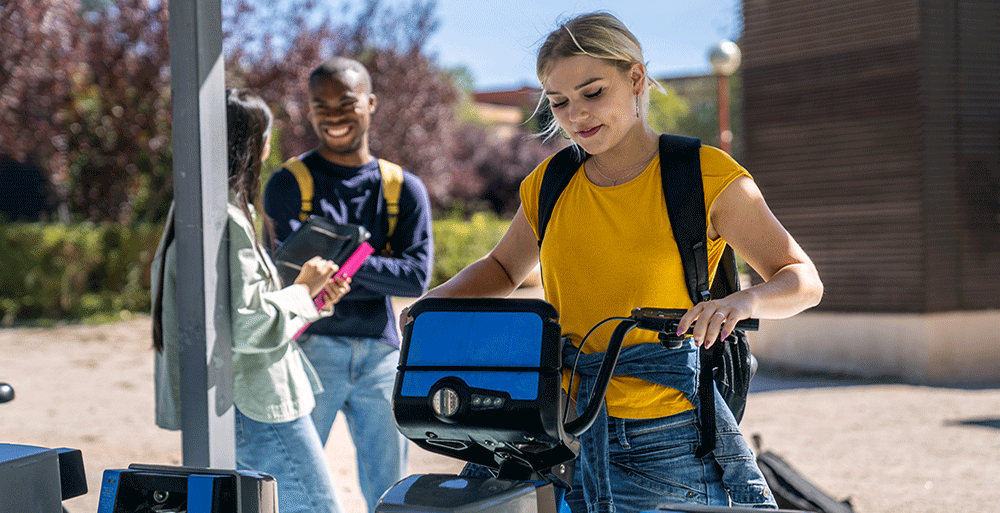College enrollment is finally rebounding after years of lower admissions due to the pandemic. With students back on campus and spring weather right around the corner, the number of people turning to e-mobility devices to get around, like e-bikes and scooters, is increasing rapidly.
In a new survey conducted by UL Standards & Engagement (ULSE) and the League of American Bicyclists, 39% of surveyed campuses reported e-mobility devices are part of daily campus life — a massive percentage considering the introduction of bike share sparked the trend less than a decade ago.
But as more students turn to e-bikes and e-scooters, safety concerns are giving rise to questions about these devices on campus. In addition to the dangers presented by e-mobility crashes, the lithium-ion batteries powering these devices pose a significant fire risk, particularly when not stored, operated, or charged properly. Even more frightening is that most owners are unaware of the deadly risks associated with these batteries, which can threaten the safety of the entire campus community.
This lack of awareness is further emphasized by new data showing almost 70% of surveyed campuses report safety concerns around e-bikes and e-scooters. Fortunately, with this new data comes appropriate steps administrations can take to reduce these risks through a combination of changes around e-mobility policy, infrastructure, and student education.
E-Bike Safety Risks on College Campuses
While unsafe riding practices and crashes are associated with any kind of mobility vehicle, the lithium-ion batteries that power e-mobility devices are frequently overlooked as safety hazards. If damaged, modified, malfunctioning, or otherwise compromised, lithium-ion batteries can go into thermal runaway: an uncontrollable, self-heating state that can lead to smoke, fire, toxic gas, or explosion.
On top of this, the way riders charge their e-bikes and e-scooters may heighten the risk of overheated batteries and fires, making adequate charging infrastructure a necessity for many institutions. Examples of unsafe practices include charging the device in a location blocking the exit, routinely charging overnight, and charging the device unattended while away from home. Unfortunately, students currently lack better options for safe charging, as only 11% of Bicycle Friendly Universities (BFUs) offer outdoor charging stations.
RELATED: How a Nonprofit Online Bike Registry Mitigates College Bike Thefts
The rapid increase of e-scooter and e-bike use at higher education institutions has created another issue: adoption is outpacing the speed with which safety measures around these devices are being implemented. Only 9% of surveyed higher education institutions have developed comprehensive policies, and there are significant gaps in enforcement.
Given the lack of awareness around battery and charging safety risks, it is important for administrations to take action to enhance e-mobility safety.
Best Practices for Reducing the College E-Bike Risk
Considering the variety of risks associated with e-mobility devices and the gaps in awareness around this issue, administrators are encouraged to take initiative to improve campus safety. ULSE supports several recommendations to ensure campuses are safe:
- Implementing clear and enforceable policies that lay out guidelines for e-bike parking, charging, and operation can make a significant impact. In addition to these reforms, higher education institutions should allocate resources for enforcement, ensuring new policies are followed by the campus community. Furthermore, it is important these policies are regularly reassessed with regard to consistency, scale, and relevance.
- Next, administrators should assess where students are parking and charging their devices. Improving e-mobility infrastructure by creating convenient, safe, and wide-reaching charging networks will deter students from unsafe charging practices. Administrators should also prioritize funding for the development of secure storage and designated parking areas to ensure devices and their batteries are not damaged when not in use.
- While the addition of new policies and infrastructure can dramatically improve safety, student education is essential. Administrators should introduce education programs on campus that provide insights on battery safety, best practices for charging e-mobility devices, and safe riding. By offering workshops, campaigns, signage, and comprehensive safety training programs for e-bike and e-scooter users, higher education institutions can effectively educate the campus community on safe e-mobility practices.
Creating a Safer Campus Life
As students return to on-campus learning, campus parking lots are getting crowded, and traffic congestion is growing. E-scooter and e-bike use will continue to play a significant role in student life for the foreseeable future — and given their benefits, they deserve a place on campus.
Administrators must act now to balance access to this efficient mode of transportation with proper safety measures. By prioritizing the development of robust policies for the safe use of e-bikes and e-scooters, enhancing e-mobility infrastructure, and improving student education, administrators can create a safer transportation experience on campus.
Anna Schnerre is Senior Quantitative Insights Analyst at UL Standards & Engagement.
NOTE: The views expressed by guest bloggers and contributors are those of the authors and do not necessarily represent the views of, and should not be attributed to, Campus Safety.







